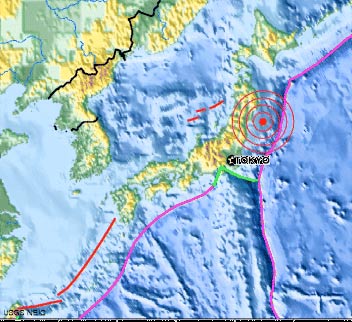Earthquakes Put Japan's Nuclear Reactors on Red Alert

The 8.9-magnitude earthquake that shook Japan early March 11 blew out the cooling systems of two nuclear reactors there. An inability to cool the reactors could cause radiation leaks, and both power plants are "bracing for the worst,” according to government officials.
[Continuing coverage of Japan disaster]
"At present we have no reports of any radioactive materials or otherwise affecting the surrounding areas," Japanese Prime Minister Naoto Kan told the press. The malfunctions are occuring at the Tokyo Electric Power Co.'s Fukushima Daiichi power plant near Tokyo and the Tohoku Electric Power Co. facility in Onagawa. Chief Cabinet Secretary Yukio Edano said that all the necessary precautions are being taken to prepare for radiation leaks, including evacuating thousands of residents within a 3-mile radius of the Fukushima facility.
Eleven reactors nearest the quake's epicenter automatically shut down upon sensing vibrations in the early hours of March 11. "Reactors shut themselves down automatically when something called 'ground acceleration' is registered at a certain point, which is usually quite small. It will instantly drop control rods into the [nuclear] core," Professor Tim Albram, a nuclear fuel engineer at the University of Manchester in the U.K., explained to the press.
Those control rods block neutrons from entering the core and inducing the fission reactions that produce nuclear energy. When the rods drop into the core, the heat put out by the nuclear fuel rods they surround plummets instantly, reducing the core's temperature to less than 5 percent of normal in a matter of seconds.
A base level of heat from nuclear decay continues to flow off the rods, however, and that's the problem in the Fukushima and Onagawa plants. Officials say they do not have enough electric power to pump water through the cooling systems and dissipate the extra heat. Water levels continue to drop.
Mark Hibbs, a nuclear expert at the Carnegie Endowment for International Peace, told Reuters that there is serious concern in Japan whether the cooling of the core and removal of residual heat could be assured. "If that does not happen, if heat is not removed, there is a definite danger of a core melt ... fuel will overheat, become damaged and melt down."
Sign up for the Live Science daily newsletter now
Get the world’s most fascinating discoveries delivered straight to your inbox.
"Even if fuel rods melt and the pressure inside the reactor builds up, radiation would not leak as long as the reactor container functions well," Tomoko Murakami, leader of the nuclear energy group at Japan's Institute of Energy Economics, told Reuters. Still, no one wants to take the chance.
The power plants are trying to restore power to its emergency power system in order to be able to pump water inside the reactors, a Tokyo Electric Power Co. spokesman said.
Natalie Wolchover was a staff writer for Live Science from 2010 to 2012 and is currently a senior physics writer and editor for Quanta Magazine. She holds a bachelor's degree in physics from Tufts University and has studied physics at the University of California, Berkeley. Along with the staff of Quanta, Wolchover won the 2022 Pulitzer Prize for explanatory writing for her work on the building of the James Webb Space Telescope. Her work has also appeared in the The Best American Science and Nature Writing and The Best Writing on Mathematics, Nature, The New Yorker and Popular Science. She was the 2016 winner of the Evert Clark/Seth Payne Award, an annual prize for young science journalists, as well as the winner of the 2017 Science Communication Award for the American Institute of Physics.










